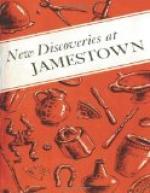The highlight of archeological discoveries at Jamestown is undoubtedly the long-forgotten buildings themselves, ranging from mansions to simple cottages. Since no accurate map of 17th-century “James Citty” is known to survive, and as only a few land tracts, often difficult to adjust to the ground, have come down to us, archeologists found that the best way to discover evidence was to cast a network of exploratory trenches over the area of habitation.
During its whole century of existence, the settlement was never an integrated town. The first frame houses quickly rotted away or succumbed to frequent fires. Brick buildings were soon erected, but probably not twoscore ever stood at one time during the 17th century.
Bearing in mind that the massive church tower is the only 17th-century structure remaining above ground today, and the only building whose identity was therefore never lost, you will find only one other identified with positive assurance—the Ludwell House—Third and Fourth Statehouses row. The remaining 140 structures so far discovered by excavating have no clear-cut identity with their owners. To complicate matters more, bricks from many burned or dismantled houses were salvaged for reuse, sometimes leaving only vague soil-shadows for the archeologist to ponder. From artifacts associated with foundation traces, relative datings and, usually, the use of the structure can be deduced from physical evidence. Unless a contemporaneous map is someday found, we shall know little more than this about the houses at Jamestown except for the testimony of assorted hardware, ceramics, glassware, metalware, and other imperishable reminders of 17-century arts and crafts.
Churches
The first church service at Jamestown was held under a piece of sailcloth in May 1607. The first frame church, constructed within the palisades, burned with the entire first fort in January 1608, and was eventually replaced by another frame structure after the fort was rebuilt. The exact date of the first church to stand on a brick foundation is uncertain, possibly 1639. Brick foundation traces, uncovered in 1901 by John Tyler, Jr., a civil engineer who volunteered his services for the Association for the Preservation of Virginia Antiquities, lie behind the free-standing brick church tower which remains the only standing ruin today. The modern brick structure and roof enclose and protect the footing evidence of the walls of two separate churches and a tile chancel flooring. Indication of fire among these foundations was noted by Tyler.
[Illustration: A mansion structure or public building dating from the second quarter of the 17th century. Rebuilt once and burned about the time of Bacon’s rebellion, 1676.]




